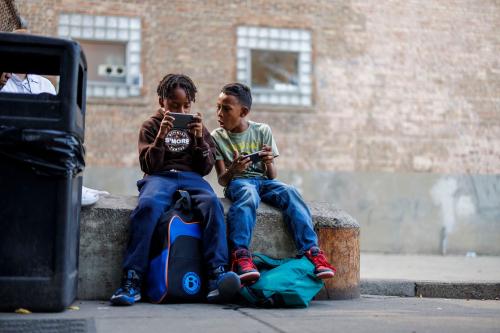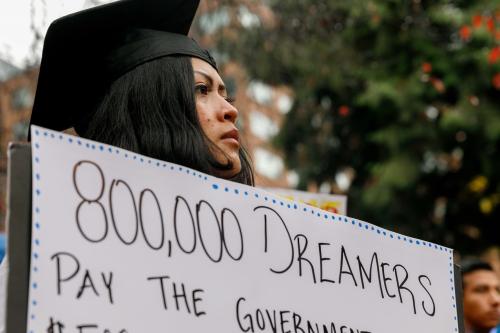The Supreme Court affirmed in Plyler v. Doe (1982) that children have a right to public education regardless of their immigration status and that states cannot enact policies or laws that deny immigrant youth’s access to public schools. However, amid the Trump administration’s aggressive immigration enforcement, many states have taken actions that could threaten immigrant children’s constitutional right to attend K-12 schools.
In this context, reports of fear, anxiety, and stress from educators and immigrant youth have been rampant. These reports have come even from sanctuary communities that have historically been welcoming toward immigrant youth.
Here, I examine the profile of immigrant youth in U.S. schools and the legislation that may threaten their access to an education. I also consider the impacts of increased immigration surveillance and anti-immigrant policies on youth and the schools that serve them.
Who are the immigrant youth enrolled in US public schools?
One challenge that educators and policymakers face is a lack of understanding—and data—about who immigrant children are, where they come from, and how much it costs to educate them. Due to privacy protections, schools do not collect data specifically on immigrant students. Instead, school systems estimate their number of immigrant students using enrollment numbers for English learners (ELs). These enrollment numbers are the basis for federal allocations for Title III funds that are focused on supporting English learners and immigrant youth.
However, using the count of ELs as a proxy for immigrant youth enrollment is far from perfect, as ELs include both foreign and native-born students. Most foreign-born students are Hispanic—from Central or South America (about 54%)—though U.S. public schools enroll a diverse group of immigrant children, including many from Asia (about 22%). Notably, only about 15% of English learners in U.S. schools during the 2020-21 school year were “recent immigrants” who had been in the U.S. for three years or less. One implication is that while some actions and rhetoric may target immigrants in particular, many others will affect—and, very likely, harm—both immigrant and native-born students.
A barrage of policies targeting immigrant students
Over the last few months, we have seen an extraordinary number of policies aimed at immigrant students, with many more that will have indirect effects on this population.
At the federal level, the Trump administration has sought to limit undocumented immigrants’ access to early childhood education, career education, and adult education programs. Most recently, a July 10, 2025, rule change would bar many immigrant families from enrolling in Head Start, leaving an estimated 115,000 children and families vulnerable to losing early education, health, and nutritional services. Earlier in the summer, the administration also temporarily withheld over $6 billion in K-12 federal education grants, including Title III funds that support English learners and immigrant students. While Title III funds have been unfrozen as of August 2025, states and local districts still find themselves trying to navigate the administration’s erratic policymaking. In my research, I have seen districts scramble to plan for defunding and avoid cuts in critical personnel who serve immigrant youth and families (e.g., teachers and school-based mental health professionals).
Meanwhile, several states have punished, or threatened to punish, districts that support the enrollment of immigrant children. Some states have proposed legislation that could threaten immigrant children’s constitutional right to attend K-12 schools. This comes despite the unambiguous decision in Plyler that affords children a right to public education regardless of immigration status.
I have been tracking this state-level activity in my research (as have other policy and legal advocates). As of August 2025, I identified nine states that have proposed legislation to ban undocumented students or punish districts that enroll immigrant students with precarious legal statuses (Georgia, Idaho, Indiana, Louisiana, New Jersey, Ohio, Oklahoma, Tennessee, and Texas). A few of these states have proposed multiple bills that threaten educational access for immigrant students (e.g., Oklahoma, Tennessee, and Texas). Although some of these bills have failed since initial data collection (e.g., H.B. 1394 in Indiana; SB036/HB0793 in Tennessee; H.B. 371 in Texas), the outcome of others remains uncertain. With most legislative sessions adjourned until the fall, additional educational bills related to vouchers that exclude immigrant students and limits to other social and family benefits and services will be under consideration in the coming months.
As of August 2025, at least four states1 have introduced legislation that would require schools or parents to collect or report students’ immigration status, raising serious concerns about data privacy and potential misuse. Additionally, some states have proposed tuition or enrollment restrictions that echo the very kinds of access barriers struck down in the Plyler v. Doe decision (e.g., Indiana-HB1394 and Tennessee-HB0793). This signals a direct legal challenge to immigrant children’s right to public education. Louisiana’s recent move (S.B. 100) goes beyond challenging Plyler v. Doe—it would permit the state to collect immigration status information from anyone seeking state services.
Anti-immigrant policies affect youth belonging, school attendance
I have longstanding research partnerships with school districts and schools that largely enroll Hispanic students and language learners. The schools and communities that I partner with have witnessed ICE raids in workplaces, with direct implications for students’ sense of belonging and mental health. One high school student said it’s “heartbreaking,” while another said, “It’s all, all on our minds.” Some educators have described the challenge of celebrating their students’ and families’ achievements at events like graduation, or through culturally humanizing practices, amid the widespread fear, anxiety, and confusion in their communities.
Teachers and school-based personnel (e.g., counselors and other staff) have kept close relationships and report trying to keep families safe during a “terrifying time.” In addition to managing their usual instruction and school administration roles, educators now face increased urgency to navigate and understand a changing and hostile policy terrain impacting immigrant youth and families.
In prior published research using survey data from an ongoing research study about immigrant and minoritized youth belonging, I show that immigrant youth’s sense of belonging is shaped by experiences of racialization and exclusion in communities. Other scholars have drawn similar conclusions. Even as schools and districts attempt to combat youths’ feelings of exclusion, many Hispanic youths, ELs, and children with foreign-born parents express feeling discriminated against when trying to access public benefits and social services due to their race/ethnicity and immigration status. They also report feeling unsafe in their communities due to fear of immigration enforcement and looming encounters with immigration courts or agents. In this context, we should not be surprised that student attendance has suffered.
Schools have been safe havens and places for immigrant families to access resources and knowledge, and to build coalitions, solidarity, and partnerships. Economic research shows the importance of immigrant students being in spaces with non-immigrant students and how the cultural diversity in schools matters and improves academic performance and engagement. Yet, these spaces are increasingly under threat.
School leaders and community advocates can help
At a time when immigrant youth and U.S.-born youth with immigrant parents feel vulnerable in their communities due to both perceived and real immigration threats, many schools and districts—along with community-based organizations—are working to strengthen safety plans, expand protections, and sustain welcoming school climates. District leaders also are speaking out against the hostile anti-immigrant climate or filing litigation. Policy and legal advocates across the country will continue to fight, and schools can concretely take action to protect the well-being and belonging of immigrant youth.
However, what schools can do often depends on local capacity, leadership, and available resources. At the school level, ensuring teachers and leaders build awareness and knowledge about policies impacting immigrant youth and families—facilitating strong relationships with families and community groups—is critical. So, too, is building coalitions among policy and legal advocates through partnerships with community-based organizations.
-
Acknowledgements and disclosures
The author wishes to thank members of her research team for ImmigrantEdNext Lab, including Melissa Ortiz, Emmy Yang, Dulce Lopez Alvarez of New York University and Lisa Lopez-Escobar of University of Maryland.
-
Footnotes
- At the time of publication, states that introduced legislation related to the collection or reporting of immigration status include Idaho (H0382), Texas (H.B. 160, H.B. 5371), New Jersey (A.B. 5233), and Indiana (H.B. 1394).
The Brookings Institution is committed to quality, independence, and impact.
We are supported by a diverse array of funders. In line with our values and policies, each Brookings publication represents the sole views of its author(s).







Commentary
What harsh immigration policies mean for students, families, and schools
August 25, 2025